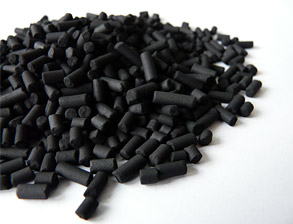What is Activated Carbon?

Activated Carbon is a material of extremely high porosity presenting a large interior surface area in a range of 600 to 1.500 m2/g which allows the adsorption of a great number of substances from gaseous or liquid phases.
The
manufacturing and activation process and the
basic raw materials used have a determining influence on the adsorptive capacity of activated carbon products in use.
Raw material may be charcoal, bituminous coal, wood, coconut shells, olive stones, fruit stones, peat etc..
Activation may be done with two different processes:
In the
Gas Activation Process, previously carbonised material is subjected to the oxidising action of gas, such as steam, carbon dioxide, air or a mixture of these. Activation temperatures typically range from 700 to 1,000 °C.
In the
Chemical Activation Process non-incinerated carbonaceous materials such as sawdust are initially mixed with dehydrating or oxidising chemicals like zinc chloride or phosphoric acid and heated up to between 400 and 800 °C under exclusion of oxygen.
The activation agent is then washed out and recovered.
The activation process itself is carried out in rotary kilns, multiple hearth, shaft or fluidised bed furnaces or in fluid bed reactors. The most common
product forms of activated carbon include:
- extruded (usually in the form of cylindrical pellets)
- broken (granular or broken activated carbon)
- powder (in specified particle sizes)
The selection of the most suitable type of activated carbon for a specific application depends on the physical and chemical properties of the substances to be adsorbed. Aside from this material data, other process-related factors also play a role in the adsorption process.
Characteristic Data and Performance Testing
Depending on the raw materials and activation methods employed, activated carbon may differ widely with respect to quality and adsorptive properties. These differences are reflected in the characteristic data (quality features) of the various grades of activated carbon.
In general, carbon properties are described on the basis of characteristic data. Apart from our own laboratory test procedures, international testing standards are given high priority, particularly the methods recommended by such bodies as
- ASTM (American Society for Testing and Materials),
- AWWA (American Water Works Association) und
- CEFIC (Conseil Européen des Fédérations de l'Industrie Chimique)
Also applicable to the grading of carbons used in water purification are the regulations contained in
- European Standard (DIN EN / CEN Comité Européen de Normalisation) and
- FCC (Food Chemicals Codex IV Edition 1996).
Further technical documents and samples will be provided upon request.